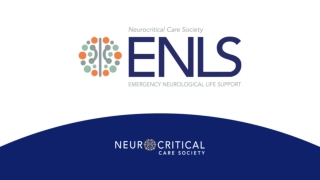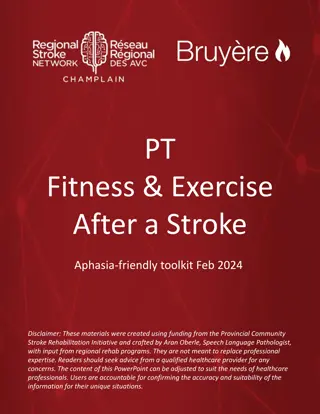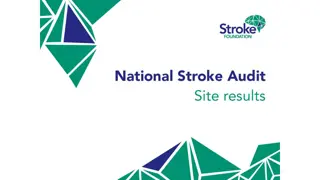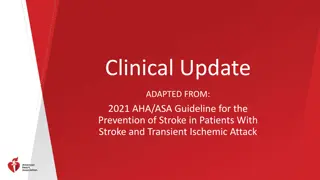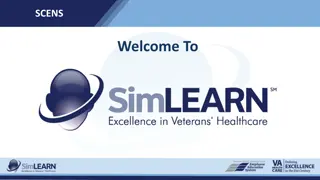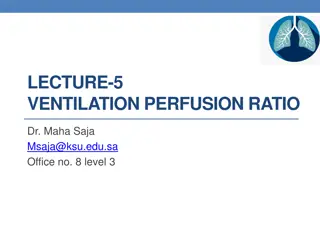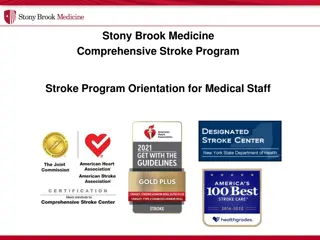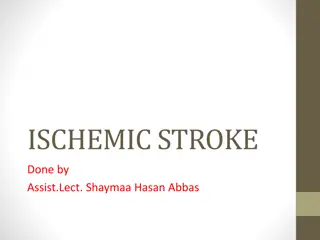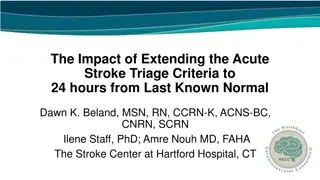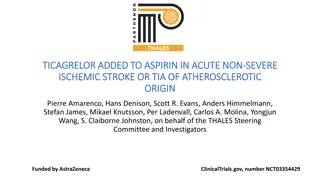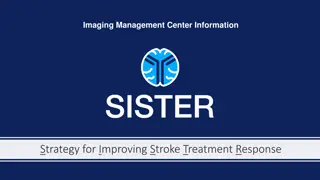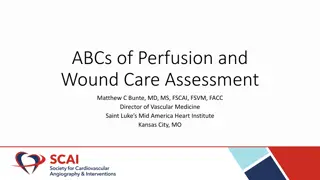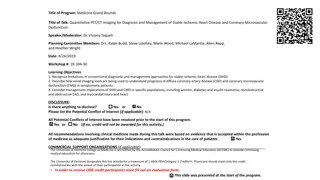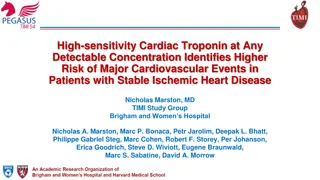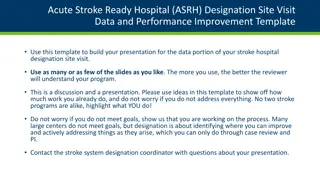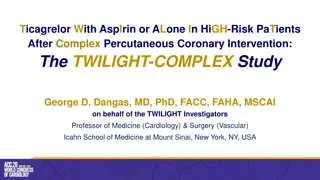Automated CT Perfusion Imaging in Acute Ischemic Stroke: Overview
This presentation delves into the significance of automated CT perfusion imaging in diagnosing and treating acute ischemic stroke. It covers essential information such as the burden of stroke in Ontario, the critical aspect of time in stroke treatment, hyperacute stroke treatment goals, and the importance of rapid access to stroke treatment. The document emphasizes the need for advanced imaging modalities for efficient stroke care and highlights the benefits of automated CT perfusion imaging for hospital settings.
Download Presentation

Please find below an Image/Link to download the presentation.
The content on the website is provided AS IS for your information and personal use only. It may not be sold, licensed, or shared on other websites without obtaining consent from the author. Download presentation by click this link. If you encounter any issues during the download, it is possible that the publisher has removed the file from their server.
E N D
Presentation Transcript
Automated CT Perfusion Imaging in the Diagnosis and Treatment of Acute Ischemic Stroke OCTOBER 2023
About this Document This presentation was developed to provide an overview of Automated CT Perfusion Software for hospitals that may benefit from this advanced imaging modality. Information included in this presentation: Background information on Stroke An overview of hyperacute stroke treatment, focusing on Endovascular Thrombectomy (EVT) An overview of the provincial imaging requirements for Acute Stroke An overview of CT Perfusion Imaging An introduction to the RAPIDAI Software and provincial sourcing agreement Disclaimer: This presentation does not cover all aspects of imaging/interpreting CT Perfusion, but rather aims to provide a basic understanding of acute stroke imaging and the benefits of automated CT perfusion for administrative leaders.
The Burden of Stroke in Ontario Leading cause of death & disability: Annual healthcare costs greater than $1Billion1 Community Supports Hyperacute & Acute Inpatient & Community Rehab Approximately 25,000 Ontarians experience a stroke every year 2 2nd highest patient group in inpatient setting after orthopedics Greater than 350,000 currently living with the consequences of stroke 5 Approximately 17,400 unique stroke/TIA patients were admitted to hospital 3 Approximately 5,500 admissions to a rehab bed every year4 Improved quality of stroke care in Ontario requires an integrated approach to maximize access to expert stroke services across the continuum. 3
Time is Brain Stroke is a medical emergency. It is critical that stroke patients are identified and triaged by EMS personnel in a timely manner to ensure rapid access to stroke treatment. Approximately 2 million neurons, 12 km of axons and 14 billion synapses are lost each minute that treatment is delayed6. Every minute saved in onset-to-treatment granted on average 4.2 days of extra healthy life7. The ischemic brain ages 3.6 years each hour without treatment6. Dead Dead Dead Salvageable Tissue Salvageable Tissue Salvageable Tissue TIME 4
Hyperacute Stroke Treatment 5
The Goal of Hyperacute Stroke Treatment Identify patients who may be eligible for acute stroke treatments. Rapid assessment of all patients with a suspected stroke. Initiate treatment as soon as possible. Restore blood flow to the brain. 6
Treatments for Acute Ischemic Stroke THROMBOLYSIS ENDOVASCULAR THROMBECTOMY (EVT) THROMBOLYSIS & EVT Thrombolytic agent administered intravenously that dissolves the clot (clot buster). IV thrombolysis must be delivered within 4.5 hours of stroke symptom onset. Mechanical removal of a clot using a catheter and stent and aspiration device. EVT is ideally performed within 6 hours of stroke symptom onset. However, this time window may be extended to 24 hours for a highly selected group of patients. A patient can receive both IV thrombolysis and EVT. 7
Accessing Hyperacute Stroke Care in Ontario 44 thrombolysis capable centres (including EVT centres). 11 EVT capable centres. EVT is a highly specialized procedure that is only provided at 11 hospitals within Ontario. A provincial process has been established to support regional access to EVT. This process involves local assessment, collaborative identification of EVT candidates, and use of CritiCall Ontario to facilitate referral and transfer. All referring hospitals should have 24/7 rapid access to diagnostic imaging to accurately identify potential EVT candidates for transfer. 8
Access to Hyperacute Treatments Access to hyperacute stroke care is variable across the province: Access to tPA ranges from 6.8-14.9%8 Access to EVT ranges from 2-9%8 Standardized tPA Rate, FY 2020/21 EVT Treatment Rate, FY 2020/21 9
Endovascular Thrombectomy 10
Endovascular Thrombectomy (EVT) Medical Treatment (no EVT) EVT is an image guided procedure that uses a catheter to physically remove the clot. In 2015, five individual trials (ESCAPE, MR. CLEAN, REVASCAT, EXTEND IA, SWIFT PRIME) established that thrombectomy significantly reduces disability rates for patients experiencing acute ischemic stroke caused by a proximal occlusion of a large vessel in the anterior circulation. 9,10,11,12,13 EVT (with medical treatment) These landmark trials evaluated EVT in the earlier time windows (i.e., 0-12-hours9, 0- 6-hours10, or 0-4.5-hours11 from time last known well) ESCAPE Trial Results3 11
Time to Treatment with EVT and Outcomes Metanalysis of the 5 landmark trials, found that the effectiveness of EVT was greatest with time from symptom onset to arterial puncture for thrombectomy of under 2 hours and became nonsignificant after 7.3 hours. 14p.1 However, there are still some patients who may experience benefits from EVT even after the conventional 6 hour time window. Image obtained from: Saver JL, Goyal M, van der Lugt A, et al. Time to treatment with endovascular thrombectomy and outcomes from ischemic stroke: a meta-analysis. JAMA 2016;316:1279-1288 12
Fast Versus Slow Progressors of Infarct Growth In acute ischemic stroke, the ischemic core represents dead tissue. Without reperfusion, tissue surrounding the core (penumbra) is at risk of death due to decreased blood flow. Progression of the penumbra to infarction depends on the length of time that blood flow to the area is interrupted and the ability for adjacent arteries to compensate for the decreased blood flow (collateral circulation).15 This progression varies from person to person. For some it happens quickly, for others it happens slowly (fast vs. slow progressors).15 The infarct core will develop slowly in patients with good collateral circulations making them potential candidates for EVT beyond the classic therapeutic time windows. This was the background for the later window trials (i.e., DAWN16 and DEFUSE 317). Image obtained from Rocha, M., & Jovin, T. G. (2017). Fast versus slow progressors of infarct growth in large vessel occlusion stroke. Stroke, 48(9), 2621 2627. https://doi.org/10.1161/strokeaha.117.017673 13
Expanding the Treatment Window for EVT DAWN TRIAL16 In 2018, two randomized control trials (DAWN and DEFUSE 3) demonstrated the benefit of mechanical thrombectomy for select patients presenting with proximal large vessel occlusion (LVO) presenting within 6-24 hours after symptom onset.16,17 In response to these trials, the Canadian Stroke Best Practice Recommendations were updated in 2018 to include EVT as a treatment option for highly selected patients with acute ischemic stroke presenting within 6-24 hours of last known well.18 DEFUSE 3 TRIAL17 In 2021, Ontario Health-CorHealth s Provincial Hyperacute Stroke Care Steering Committee recommended that Ontario move forward with a 24-hour hyperacute stroke treatment window for selected patients.19,20 14
Selecting Patients for Endovascular Thrombectomy 15
Determining Eligibility for EVT* Clinical Assessment Time from symptom onset: Up to 6 hours of stroke symptom onset qualify for EVT. Select patients in 6 to 24-hour time window Patient does not have severe pre-stroke impairments, co- morbidities, or is not palliative with end-of-life care. The stroke is disabling (e.g., NIHSS> 4). Diagnostic Imaging: Confirmed large vessel occlusion (LVO) with a reachable clot in the anterior circulation (MCA, ICA). Patients presenting with occlusion of the posterior circulation may be considered.18 Small to moderate ischemic core (ASPECTS 6) Evidence of salvageable brain tissue (particularly relevant in the 6 24-hour time window when significant time has passed). *This slide provides a summary of key eligibility criteria outlined in the Canadian Stroke Best Practice Recommendations and is not comprehensive.18 For further detail, refer to Box 5C- Inclusion Criteria for EVT. Evidence continues to evolve.18 Eligibility criteria may expand in the future. 16
Minimum Imaging Requirements in Ontario Imaging Tool Why is it used? Why does this matter? Thrombolysis and EVT are only indicated for patient s experiencing ischemic strokes. To exclude hemorrhage (bleed). Noncontrast CT (NCCT) Dead tissue will not recover and is at high risk for hemorrhagic transformation. Note: a normal CT does not rule out stroke as hypodensities do not typically show until several hours after infarction. To determine early ischemic changes (ASPECTS Score). To determine the presence and location of a vessel occlusion (CTA). EVT is more effective than tPA for patients experiencing a large-vessel occlusion stroke. EVT is not indicated for small vessel occlusions. To determine the best way to access the target lesion (head and neck CTA). The EVT operator must be able to access the target lesion. The access route may change depending on factors such as stenosis, tortious etc. Multiphase CT Angiography (mCTA) To evaluate the collateral circulation (adjacent arteries that can provide an alternate route for blood flow to the area). Collateral circulation indicates that there is likely salvageable tissue. Patients with good collateral circulation are more likely to have a good outcome and are at less risk for hemorrhage. As per the Provincial Acute Stroke Imaging Protocol for Endovascular Treatment, Automated CT Perfusion is preferred and strongly recommended 18
The Added Value of CT Perfusion As per the provincial Acute Stroke Imaging Protocol for Endovascular Treatment, Automated CT Perfusion is preferred and strongly recommended. Why is Automated CT Perfusion preferred (especially in the 6 24-hour window)? Although NCCT and multiphase CTA may be used to select patients in the extended time window the quality of evidence is not as robust (i.e., moderate quality of evidence), and it is not as reliable.18,21 The Alberta Stroke Program Early CT Score (ASPECTS), derived from the NCCT can be used to quantify infarct core size, enabling; however, the assessment is subjective and can be challenging, resulting in concerns regarding intra-rater reliability.22,23,24 Automated CT Perfusion (CTP provides an easier and more consistent way to estimate the core) As time progresses so does the stroke (ischemic core). Understanding whether there is still brain tissue to be saved and how long this tissue is likely to remain salvageable is critical to making treatment decisions. This information is particularly relevant when significant time has passed (i.e., in the extended treatment window), and/or the patient must be transferred to the EVT capable centre. The two groundbreaking randomized control trials demonstrating the efficacy of EVT in the 6 24-hour time window (DAWN and DEFUSE 3), required CTP to select patients (along with other criteria). 16,17 CT Perfusion enables tissue based vs. time-based treatment decisions 19
CT Perfusion Imaging: How it Works25,26 A bolus of iodinate contrast is injected intravenously. Contrast movement through the brain vasculature and tissue is captured using a sequence of scans acquired over approximately 1 minute. The image data is then transferred to a workstation where automated post-processing software (e.g., RAPIDAI) measures the attenuation curve for each pixel. The attenuation curve is then used to estimate the concentration of contrast in each pixel. The concentration is then used to calculate the following hemodynamic parameters for each pixel: Cerebral Blood Flow Cerebral Blood Volume Mean Transit Time Time to Peak Image retrieved from: Daniel V clav k., et al., The importance of CT perfusion for diagnosis and treatment of ischemic stroke in anterior circulation. J. Integr. Neurosci. 2022, 21(3), 92. https://doi.org/10.31083/j.jin2103092 21
CT Perfusion Imaging: How it Works28,29 Term Definition Interpretation Decreased CBV may indicate infarction and poor collateral circulation Cerebral Blood Volume (CBV) Volume of flowing blood in 100 grams of brain tissue. Prolonged transit times indicates reduced blood flow and changes in vascular dynamics Mean Transit Time (MTT) Average amount of time it takes blood to transit through the given volume of brain. Decreased CBF (in comparison to normal tissue) can be used to estimate ischemic core volume Cerebral Blood Flow (CBF) Volume of blood moving through a given volume of brain in a specific amount of time (CBV/MTT). Areas with longer Tmax values indicate delayed arrival of blood to a specific area of the brain. This tissue is at risk of infarction (penumbra). Time to Maximum (Tmax) Time it takes for the contrast to achieve its maximum concentration in the region of interest Predefined thresholds for each parameter are used to create color-coded maps showing areas of dead tissue and areas of at-risk tissue 22
CT Perfusion Imaging: How it is Used Source images are used to create the comprehensive Mismatch Map (right). Pink colouring reflects the volume of brain tissue with CBF < 30%. This area represents the ischemic core29 The green colouring reflects a volume of brain tissue with Tmax > 6 seconds. This area represents the penumbra - salvageable tissue.29 The difference between the core volume and penumbra volume is called the mismatch volume. The mismatch may also be presented as a ratio. Stroke specialists can use the mismatch ratio and core volume to support decision making.** Selection Criteria Used in Extended Window Trials:* ischemic core volume (CBF) < 51 mL in patients less than 80 or < 31 in patients 80; clinical mismatch. 16 ischemic core volume (CBF) < 70 ml, mismatch ration 1.8 and mismatch volume 15 ml. 17 *Note: Information may also be gleaned from the source images, and other maps provided by the software package **Additional criteria was used to select patients. CTP is one input into the decision-making process and should not be viewed in isolation of other diagnostic/clinical information. Furthermore, a strong understanding of potential pitfalls of CTP should be well understood by the clinical decision maker. 23
CT Perfusion Imaging and Patient Transfers In addition to the Mismatch Map, the Tmax Hypoperfusion Map can be used to predict infarct growth.29,30,31This information is particularly relevant for patients that require transfer to the Endovascular Thrombectomy Centre. A gradient of colors is employed to classify regions of reduced perfusion into varying degrees of intensity. Regions depicted in red signify that the tissue is in imminent danger of necrosis (i.e., Tmax >10 seconds). The ratio of tissue at immediate risk (>10 sec) and at risk (> 6 sec) has been found to correlate to collateral status (the hypoperfusion index)- an indicator of slow vs. fast progressors. 29,30 A higher hypoperfusion index (>0.34) in the DEFUSE 3 trial indicated poor collateral status and was a strong predictor of infarct growth. 29,30 If the patient is a fast progressor, transfer may be futile.32 24
Additional Uses of Automated CT Perfusion In addition to determining whether there is still salvageable tissue, CT Perfusion may also be used to: Another benefit that we have found with RAPID-AI is the ability for the Telestroke neurologist to take advantage of the extended widow for tPA administration. As you know tPA is usually administered up to the 4.5-hour mark but Canadian Stroke Best Practice Recommendations support administration up to 9 hours. We recently had a case where the Telestroke Neurologist confirmed that he was able to make the recommendation to deliver tPA at 8 hours to a patient because PRHC had RAPID-AI imagining - District Stroke Coordinator, Peterborough Regional Health Centre. Identify distal occlusions that may be difficult to identify with NCCT or CTA alone (Middle Vessel Occlusions).33 Identify stroke mimics (e.g., seizures).34 Identify patients who may benefit from thrombolysis beyond 4.5 hours35,36 (As per the Canadian Stroke Best Practice Recommendations, Intravenous thrombolysis beyond 4.5 hours may be considered, in consultation with a physician with stroke expertise and based on advanced imaging (CSBPR, 2022)). 25
Automated Vs. Manual Post Processing of CTP Manual post processing is time consuming and is more likely to result in interobserver variability. iSchemaView RAPID To date, iSchemaView RAPID automated CT Perfusion software is the only perfusion software to have been validated in clinical trials, Health Canada approved, and recommended by the Ontario Health Technology Advisory Committee. Fully automated image processing software application packages allows for quick visualization and analysis of brain physiology that runs from a standard computer. It is a standardized analysis of CTP perfusion maps that is applicable to all types of scanners. As per the Canadian Stroke Best Practice Recommendations (2022) Sites using CTP perfusion imaging should use software that provides quantifiable measurements of ischemic core and penumbra (p. 50). Quick and timely assessment of the CTP Perfusion raw images (30 seconds to 2 minutes) versus 20 minutes for postprocessing in vendor CT Software packages. It automatically post processes the images so does not require extra time or additional expertise to do the post processing of the images. 26
About RAPIDAI The following slides were developed by RAPIDAI. Ontario Health-CorHealth Ontario s role is limited to enabling the sharing of this information 27
The Rapid Platform Clinical decision support in the palm of your hand. Real-time and aggregated analytics to drive feedback loops. Team workflow across entire care continuum
Rapid CTP: Advanced CT Perfusion Analysis in Minutes Delivers quantified and color-coded CT perfusion maps to help physicians quickly assess salvageable brain tissue. The only clinically-validated software with an FDA indication to aid in the selection of patients for acute stroke therapy.
Rapid CTP: Key Features Color-coded CT perfusion maps display reduced cerebral blood flow, volume, transit time and hypodensity. Provides easy-to-interpret results in as few as 2 minutes. Clinically validated in more than 10 major multi-center clinical trials. Results and source files delivered to PACS, email, Rapid mobile app and Rapid web app.
Why RapidAI for Stroke? Save Lives, Time & Money SAVE TIME SAVE MONEY SAVE LIVES ACCURATE PROVEN FAST Our cutting-edge AI technology helps physicians make expedient diagnoses and treatment-or-transfer decisions to improve patient outcomes and save more lives. Rapid clinical results and the Rapid Workflow for Stroke mobile and web apps help align stroke care teams across hospitals, saving time so patients can get the treatment they need when they need it. Reports and analytics compiled from patient- journey data save hospital staff time while helping them identify trends to make more informed operational and financial decisions. With more than 100 publications producing an average impact factor of 12.2, RapidAI stroke products deliver proven benefits to hospitals in 20 countries redefining how they care for stroke patients. RapidAI provides physicians clinical decision support data within minutes, and care teams the ability to streamline workflows and coordinate care throughout the patient journey. Intelligence gained from over 5 million scans continues our legacy of paving the way for a new standard of care for stroke patients, originally endorsed by the American Heart Association guidelines in 2015. Four of 10 randomized endovascular therapy for stroke trials used RapidAI to select optimal patients for enrollment, which achieved substantially larger clinical benefits than the other trials. We are notified of patients in outlying hospitals with positive scans or LVOs as the scan gets done so by the time the radiologist is calling the ER...we are already aware of this patient... We continue to improve Door to Neuro Lab activation at our spoke hospitals with a best average time of 49 minutes in the last 6 months. Generated the largest return on investment for LifeBridge Rapid products have been extensively studied and validated in 14 clinical trials, resulting in improved clinical outcomes, new AHA guidelines and an extended treatment window of 24 hours. WE received the highest recognition... for rapid treatment of acute stroke patients...: door to needle time within 30 minutes for at least 50% of tPA patients. Dan Durand, MD, CIO Clinical Services, St. Luke s Baptist Hospital Michele Patterson, Director Clinical Services, St. Luke s Baptist Hospital Brijesh P Mehta, M.D., Director NeuroInterventional Surgery at Memorial Neuroscience Institute Russell Cerejo, MD Allegheny Health Network
Provincial Sourcing Strategy In 2021, the Hyperacute Stroke Care Steering Committee recommended a provincial sourcing strategy for automated CTP imaging software (specifically RAPIDAI). In response to this recommendation, Ontario Health-CorHealth enlisted MMC Plexus Sourcing Collaborative (MPSC) to design a provincial sourcing strategy for automated CTP Imaging software for all Ontario stroke sites and community hospitals. MPSC finalized an agreement with IschemaView which may be leveraged by any interested Ontario hospital (and MMC or Plexus member hospitals outside Ontario): The agreement includes a standardized pricing schedule that benefits both existing and future RAPID hospital sites. Pricing for all participants to the Agreement may further decrease as tier levels are achieved through new sites joining the agreement. Further details regarding the agreement and implementation steps were distributed to key stakeholders on July 22, 2022 (i.e., Executive Summary, Form of Agreement and Implementation Playbook). 33
Summary of Ontario Agreement License Options Included Features Add Ons Option 1: All current stroke module (CTP/MRI/CTA-LVO/ICH/ASPECTS) for 1 scanner for 1 site. Option 2: All current stroke modules for unlimited scanners for 1 site. Rapid WebApp Rapid Pre-Scan Workflow Rapid Insights Standard Reports for up to 3 users per site Rapid Insights Enterprise Reports for up to 3 users per site Rapid for Angio for 1 scanner EMR integration Unlimited number of cases for licensed scanners Unlimited users to Rapid Mobile App w/ In-App Communication Unlimited users to Rapid U online training & certification platform Live Webinar Training Sessions with Clinical Experts Access to Rapid Insights Standard Reports for up to 3 users per site for the first year 365 x 24 x 7 support Hospitals interested in purchasing RAPIDAI should engage their Regional Stroke Network Director to learn more about leveraging the provincial agreement. 34
Summary 35
Summary Automated CT Perfusion imaging provides valuable information about cerebral perfusion and tissue viability. This information can be used to: Better identify patients who may benefit from EVT, especially in the extended treatment window Make tissue based vs. time based treatment decisions Inform discussions with patient and family regarding prognosis Help identify patients with stroke mimics and those with distal vessel occlusions Reduce futile transfers To date, iSchemaView RAPID automated CT perfusion software is the only validated software with an FDA indication to aid in the selection of patients for acute stroke therapy. Access to Automated CT Perfusion is strongly recommended at both the provincial and national level 36
References 37
References 1. Chan B, Hayes B. Cost of stroke in Ontario, 1994/95. Canadian Medical Association Journal 1998; 159:S2-S8 https://www.ncbi.nlm.nih.gov/pmc/articles/PMC1255891/pdf/cmaj0159006000S2.pdf Kamal N, Lindsay PM, C t R, Fang J, Kapral MK, Hill MD. Ten-year trends in stroke admissions and outcomes in Canada Can J Neurol Sci. 2015; 00: 1-8 Pardhan, A. et al.(2021) Ontario Stroke Report FY 2020/21, CorHealth Ontario Discharge Abstract Database (DAD), National Ambulatory Care Reporting System (NACRS), National Rehabilitation System (NRS) FY 2017/18, 2019/20 CorHealth, Analytic Team estimation of prevalence for Ontario Health CIQP Town Hall presentation Jan 10 2022 Saver, J. Time is Brain Quantified. Stroke. 2006;37:263-266. Available at https://doi.org/10.1161/01.STR.0000196957.55928.abStroke. Meretoja A., Keshtkaran M., Tatlisumak T., Donnan G.A.. & Churilov L. Endovascular therapy for ischemic stroke: save a minute save a week. Neurology. 2017;88:2123-2127 Ontario Health-CorHealth Ontario (2022). Ontario Stroke Report 2020/2021 O. Berkhemer, P. Fransen, et. al, A Randomized Trial of Intraarterial Treatment for Acute Ischemic Stroke. N Engl J Med 2015; 372:11-20. (Mr. CLEAN) M. Goyal, A. Demchuk, et. al. Randomized Assessment of Rapid Endovascular treatment of Ischemic Stroke. N Engl J Med 2015; 372:1019-30 (ESCAPE) B.C.V Campbell, P.J Mitchell et. al. Endovascular Therapy for Ischemic Stroke with Perfusion-Imaging Selection. N Engl J Med 2015; 372:1009-18 (EXTEND-IA) Saver, M. Goyal et. al Stent-Retriever Thrombectomy After Intravenous t-PA vs. t-PA Alone in Stroke. N Engl J Med 2015; 372:2285-2295 (SWIFT PRIME) T. Jovin, A. Chamorro, et. al. Thrombectomy within 8 hours after Symptom Onset in Ischemic Stroke. N Engl J Med 2015; 372:2296-2306 (REVASCAT) Saver JL, Goyal M, van der Lugt A, et al. Time to treatment with endovascular thrombectomy and outcomes from ischemic stroke: a meta-analysis. JAMA 2016;316:1279-1288 Rocha, M., & Jovin, T. G. (2017). Fast versus slow progressors of infarct growth in large vessel occlusion stroke. Stroke, 48(9), 2621 2627. https://doi.org/10.1161/strokeaha.117.017673 Lindsay, E. (2018). Thrombectomy 6 to 24 hours after stroke with a mismatch between deficit and infarct. The Journal of Emergency Medicine, 54(4), 583 584. https://doi.org/10.1016/j.jemermed.2018.02.029 Albers GW, Marks MP, Kemp S, et al. Thrombectomy for stroke at 6 to 16 hours with selection by perfusion imaging. N Engl J Med. 2018;378:708 18. 2. 3. 4. 5. 6. 7. 8. 9. 10. 11. 12. 13. 14. 15. 16. 17. 38
References 18. Heran, M., Lindsay, P., Gubitz, G., Yu, A., Ganesh, A., Lund, R., . . . Shamy, M. (2022). Canadian Stroke Best Practice Recommendations: Acute Stroke Management Module, 7th Edition Practice Guidelines Update, 2022. Heart and Stroke Canadian Stroke Best Practices website, 1-162 CorHealth Ontario. Letter RE: Expanding Coverage of Telestroke up to 24 hours from stroke symptom onset. Retrieved from: https://www.corhealthontario.ca/Cover-Letter-for-24hour-referral-worksheet-and-algorithm.pdf Ontario Health-CorHealth Ontario. EVT Stroke Treatment Centre Service Delviery Requirements. Retrieved from: https://www.corhealthontario.ca/EVT-Centre- Service-Delivery-Requirements-February-2021-fillabl-form.pdf Albers, G. W. (2018). Use of imaging to select patients for late window endovascular therapy. Stroke, 49(9), 2256 2260. https://doi.org/10.1161/strokeaha.118.021011 McTaggart RA, Jovin TG, Lansberg MG, et al.; DEFUSE 2 Investigators. Alberta stroke program early computed tomographic scoring performance in a series of patients undergoing computed tomography and MRI: reader agreement, modality agreement, and outcome prediction. Stroke 2015; 46:407 412 64. Kobkitsuksakul C, Tritanon O, Suraratdecha V. Interobserver agreement between senior radiology resident, neuroradiology fellow, and experienced neuroradiologist in the rating of Alberta Stroke Program Early Computed Tomography Score (ASPECTS). Diagn Interv Radiol 2018; 24:104 107 65. Farzin B, Fahed R, Guilbert F, et al. Early CT changes in patients admitted for thrombectomy: Intrarater and interrater agreement. Neurology 2016; Kurz, K. D., Ringstad, G., Odland, A., Advani, R., Farbu, E., & Kurz, M. W. (2016). Radiological imaging in acute ischaemic stroke. European journal of neurology, 23 Suppl 1, 8 17. https://doi.org/10.1111/ene.12849 Laughlin B, Cahn A, Tai WA, Moftakhar P. RAPID automated CT perfusion in clinical practice. Pract Neurol 2019;2019:41 55.[Google Scholar] Daniel V clav k, Ondrej Voln , Petra Cimflov , Krystof vub, Katerina Dvorn kov , Michal Bar. The importance of CT perfusion for diagnosis and treatment of ischemic stroke in anterior circulation. J. Integr. Neurosci. 2022, 21(3), 92. https://doi.org/10.31083/j.jin2103092 Ontario Health. Automated CT perfusion imaging to aid in the selection of patients with acute ischemic stroke for mechanical thrombectomy: a health technology assessment. Ont Health Technol Assess Ser [Internet]. 2020 Nov;20(13): 1 87. Available from: https://hqontario.ca/Evidence-to-ImproveCare/Health-Technology- Assessment/Reviews-And-Recommendations/Automated-CT-PerfusionImaging-to-Aid-in-the-Selection-of-Patients-with-Acute-Ischemic-Stroke-for- MechanicalThrombectomy Rybinnik, I. The Neurophile: CT Perfusion in Acute Ishcemic Stroke [recorded lecture]. Available at: from https://www.youtube.com/watch?v=LQ80snVuELs&list=TLPQMTcwODIwMjM1QUA36TKmNQ&index=2 19. 20. 21. 22. 23. 24. 25. 26. 27. 28. 29. 39
References 30. MacLellan, A., Mlynash, M., Kemp, S., Ortega-Gutierrez, S., Heit, J. J., Marks, M. P., Lansberg, M. G., & Albers, G. W. (2022). Perfusion imaging collateral scores predict infarct growth in non-reperfused defuse 3 patients. Journal of Stroke and Cerebrovascular Diseases, 31(1), 106208. https://doi.org/10.1016/j.jstrokecerebrovasdis.2021.106208 Lyndon D, van den Broek M, Niu B, Yip S, Rohr A, Settecase F. Hypoperfusion Intensity Ratio Correlates with CTA Collateral Status in Large-Vessel Occlusion Acute Ischemic Stroke. AJNR Am J Neuroradiol. 2021 Aug;42(8):1380-1386. doi: 10.3174/ajnr.A7181. Epub 2021 Jun 17. PMID: 34140276; PMCID: PMC8367626. Guenego A, Mlynash M, Christensen S, Kemp S, Heit JJ, Lansberg MG, Albers GW. Hypoperfusion ratio predicts infarct growth during transfer for thrombectomy. Ann Neurol. 2018 Oct;84(4):616-620. doi: 10.1002/ana.25320. Epub 2018 Sep 23. PMID: 30168180. Amukotuwa SA, Wu A, Zhou K, Page I, Brotchie P, Bammer R. Distal Medium Vessel Occlusions Can Be Accurately and Rapidly Detected Using Tmax Maps. Stroke. 2021 Oct;52(10):3308-3317. doi: 10.1161/STROKEAHA.120.032941. Epub 2021 Jul 8. PMID: 34233460. Heit, J. & Wintermark, M. Perfusion computed tomography for the evaluation of acute ischemic stroke: strengths and pitfalls. Stroke 47, 1153 1158 (2016). Ma H, Campbell BCV, Parsons MW, Churilov L, Levi CR, Hsu C, Kleinig TJ, Wijeratne T, Curtze S, Dewey HM, Miteff F, Tsai CH, Lee JT, Phan TG, Mahant N, Sun MC, Krause M, Sturm J, Grimley R, Chen CH, Hu CJ, Wong AA, Field D, Sun Y, Barber PA, Sabet A, Jannes J, Jeng JS, Clissold B, Markus R, Lin CH, Lien LM, Bladin CF, Christensen S, Yassi N, Sharma G, Bivard A, Desmond PM, Yan B, Mitchell PJ, Thijs V, Carey L, Meretoja A, Davis SM, Donnan GA; EXTEND Investigators. Thrombolysis Guided by Perfusion Imaging up to 9 Hours after Onset of Stroke. N Engl J Med. 2019 May 9;380(19):1795-1803. doi: 10.1056/NEJMoa1813046. Erratum in: N Engl J Med. 2021 Apr 1;384(13):1278. PMID: 31067369. Thomalla G, Boutitie F, Ma H, Koga M, Ringleb P, Schwamm LH, Wu O, Bendszus M, Bladin CF, Campbell BCV, Cheng B, Churilov L, Ebinger M, Endres M, Fiebach JB, Fukuda-Doi M, Inoue M, Kleinig TJ, Latour LL, Lemmens R, Levi CR, Leys D, Miwa K, Molina CA, Muir KW, Nighoghossian N, Parsons MW, Pedraza S, Schellinger PD, Schwab S, Simonsen CZ, Song SS, Thijs V, Toni D, Hsu CY, Wahlgren N, Yamamoto H, Yassi N, Yoshimura S, Warach S, Hacke W, Toyoda K, Donnan GA, Davis SM, Gerloff C; Evaluation of unknown Onset Stroke thrombolysis trials (EOS) investigators. Intravenous alteplase for stroke with unknown time of onset guided by advanced imaging: systematic review and meta-analysis of individual patient data. Lancet. 2020 Nov 14;396(10262):1574-1584. doi: 10.1016/S0140-6736(20)32163-2. Epub 2020 Nov 8. PMID: 33176180; PMCID: PMC7734592. 31. 32. 33. 34. 35. 36. 40


